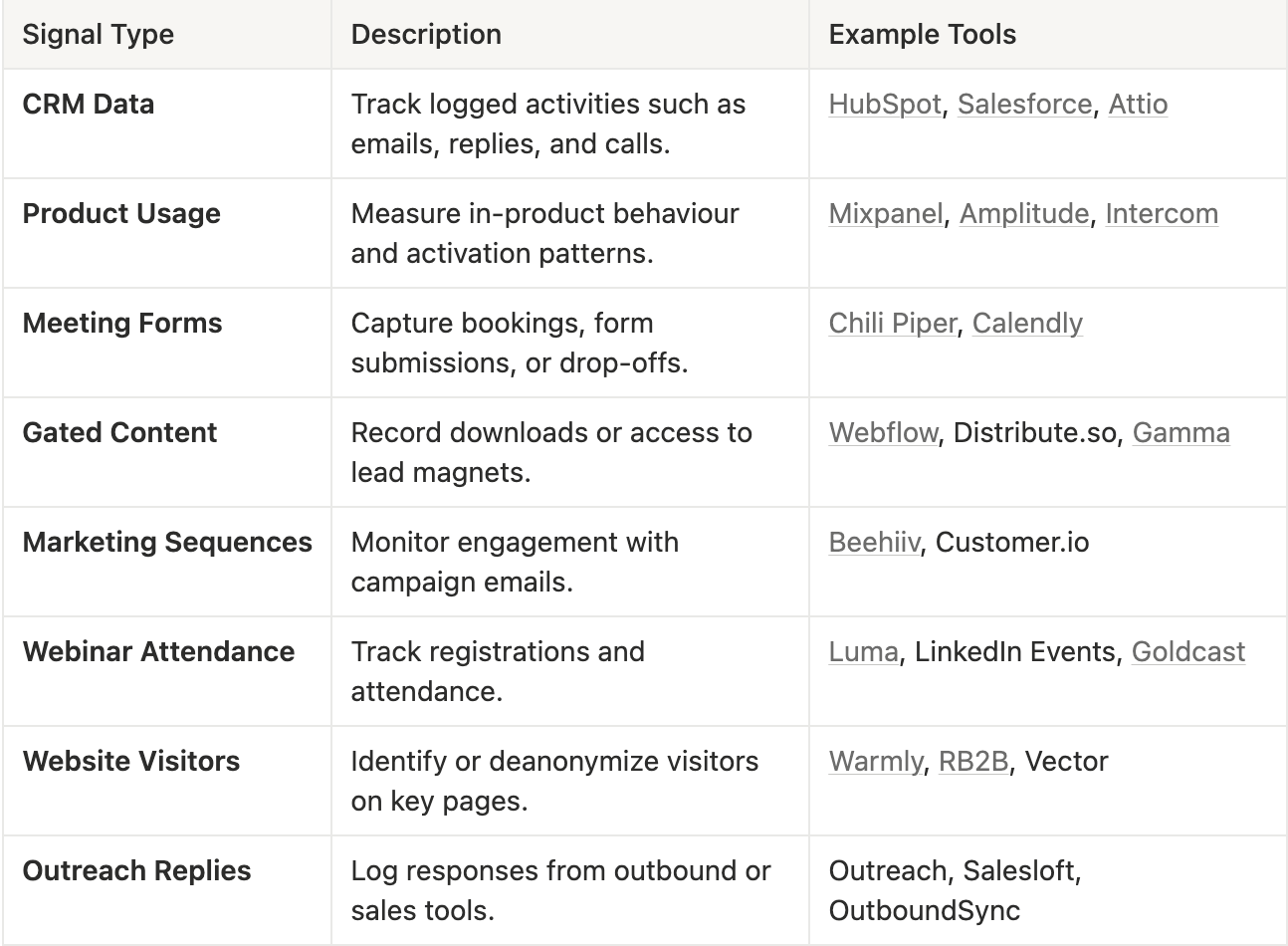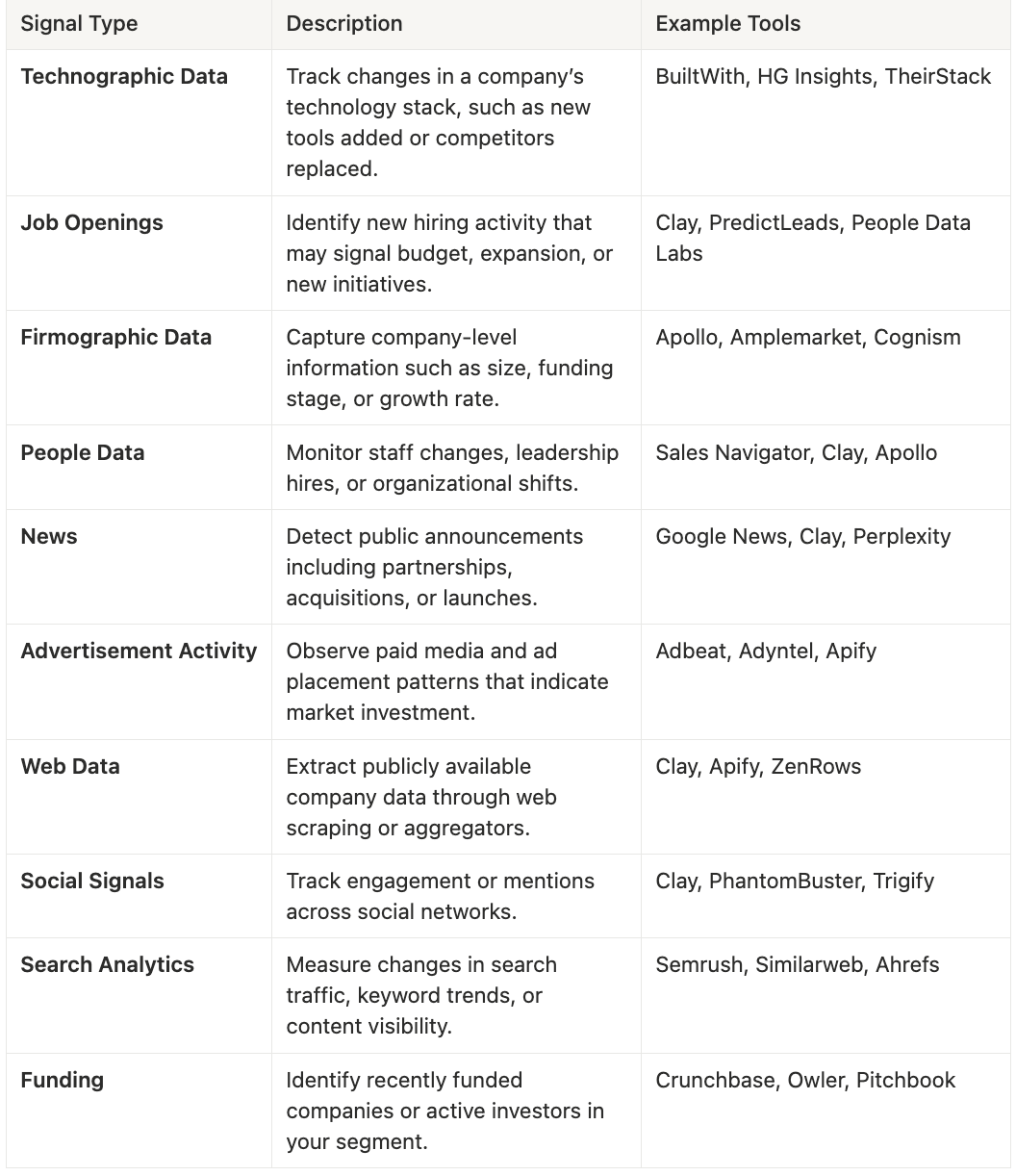Introduction
Go-to-market systems run on data, but most teams do not use that data in real time.
Signals are collected from CRMs, product analytics, websites, and external tools, yet they often stay isolated instead of driving action.
Signals form the base layer of intent-driven GTM. They reveal who is paying attention, what they are doing, and when they are ready to engage.
The purpose of this playbook is to show how to capture, classify, and activate those signals so that your team can move from raw activity to measurable intent.
This framework divides signal data into three categories: first-party, second-party, and third-party. It explains how each type supports scoring, automation, and prioritization within a GTM system.
This is a practical model for teams that want to make intent data operational, consistent, and useful across marketing, sales, and revenue operations.
The 5 Core Uses of Intent Signals
Intent signals represent measurable activity that helps teams decide where to focus.Used correctly, they make account engagement more timely, targeted, and consistent across the GTM process.
Below are the five practical ways to apply intent signals inside a modern system.
1. Lead and Awareness Scoring
Signals provide context for how aware or engaged an account is.
Website visits, product usage, and content interactions can be scored to reflect buyer readiness.
Combining multiple signal types gives a more accurate view of conversion likelihood than any single metric.
2. Trigger Automated Outreach
Specific signal patterns can start automated workflows such as outbound sequences, ads, or nurture flows.
Examples include a demo request, a spike in product activity, or a new funding event.
Automation ensures that engagement happens at the right time without manual intervention.
3. Deliver CRM and Slack Notifications
Some signals need a human response.
Connecting live signal data to Slack or CRM notifications lets sales teams act immediately when a key event occurs, such as a target account visiting pricing pages or a champion changing jobs.
4. Monitor Customer Expansion and Retention
Signals also reveal post-sale behaviour.
Tracking product usage, account engagement, and new stakeholder activity helps identify renewal risk or upsell opportunities early.
5. Build Targeted Lists for ABM
Signals refine targeting by showing which accounts are active in your market or researching related solutions.
Merging fit data with live intent signals produces focused, high-value account lists for campaign activation.
The 3 Signal Categories
Intent data comes from multiple sources.
To make it actionable, it needs to be grouped by origin and reliability.
There are three main categories of signals used in go-to-market systems:
first-party, second-party, and third-party.
- First-party signals show how prospects engage directly with your product or brand.
- Second-party signals come from trusted partners or platform integrations.
- Third-party signals capture public or aggregated external activity.
Understanding these layers helps teams build cleaner datasets, improve scoring accuracy, and reduce overlap between tools.
First-Party Signals
First-party signals are generated inside your own environment.
They capture how leads and customers interact with your brand across owned platforms.
This data is usually the most accurate, since it reflects verified user behaviour.

First-party data forms the foundation of your signal architecture.
It’s the most reliable input for awareness scoring, prioritization, and early intent detection.
Second-Party Signals
Second-party signals come from trusted partners or shared integrations.
They extend your visibility beyond owned channels and provide context that your internal systems cannot capture.
This data helps validate intent across your ecosystem and identify cross-channel engagement.

Second-party data bridges the gap between owned and public intent sources.It often highlights shared customers, mutual relationships, or overlapping audience segments that indicate stronger buying potential.
When integrated with first-party data, it improves scoring accuracy and helps prioritize accounts that are active within your partner network.
Third-Party Signals
Third-party signals are sourced from external and publicly available data.
They reveal activity that occurs outside your owned or partner environments and provide broader market visibility.
This data is useful for identifying new accounts, timing outbound motion, and understanding macro-level buying behaviour.

Third-party signals broaden market awareness and help detect early indicators of change, such as growth, investment, or technology adoption.
When combined with first- and second-party data, they enable a complete view of account intent and timing.
Building Your Signal Architecture
Collecting signals is only useful if they can be acted on.
To make signal data operational, it must be captured, organized, and distributed across your core GTM systems.
A clear signal architecture connects all three data categories: first, second, and third-party and routes them into your CRM, automation tools, and internal communication channels.
The goal is not volume, but structure: every captured signal should have a defined destination, owner, and next action.
1. Ingest Signals
Start by consolidating all signal sources into a single environment, usually your CRM or data warehouse.
Use integrations or ETL tools to automate ingestion and prevent data silos.
Each signal should include metadata such as source, timestamp, and account ID for traceability.
2. Normalize and Score
Not all signals carry the same weight.
Normalize incoming data by type and assign scoring logic based on relevance and recency.
For example, a product usage spike may count higher than a social engagement.
Weighted scoring ensures consistency across systems and avoids inflating low-intent activity.
3. Enrich Accounts
Merge signal data with existing account and contact records.
This creates a single, current view of every account, showing both firmographic fit and live intent.
Regular enrichment prevents outdated records and improves accuracy in segmentation and prioritization.
4. Trigger Automations
Use signal thresholds to automate tasks and workflows.
Examples include:
- Creating tasks or deals in the CRM.
- Sending high-priority alerts to Slack channels.
- Launching email sequences or retargeting campaigns.
- Each trigger should have clear logic to prevent alert fatigue and maintain signal quality.
5. Close the Feedback Loop
Feed outcome data back into the system.
If a signal consistently leads to meetings or deals, its weight should increase.
If it produces noise, adjust or suppress it.
A feedback loop keeps your architecture self-correcting and aligned with real outcomes.
Conclusion
Signal data is no longer optional. It is the foundation of how modern go-to-market teams operate.
When signals are captured, classified, and activated through a single system, teams stop reacting to pipeline changes and start predicting them.Every tool, CRM, Slack, automation, and analytics, becomes part of one connected process that runs on real buyer activity.
A functional signal architecture replaces guesswork with visibility.It shows which accounts are moving, which contacts are active, and which plays create measurable impact.
At this level, signals are not a data source.They are the operating system behind GTM alignment, decision-making, and growth.





.svg)








